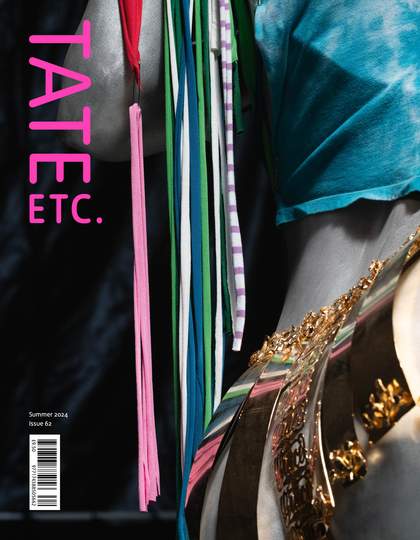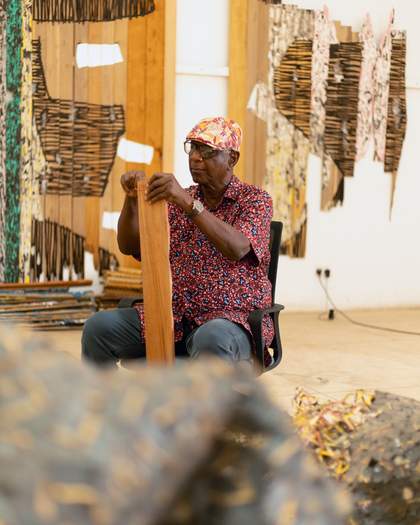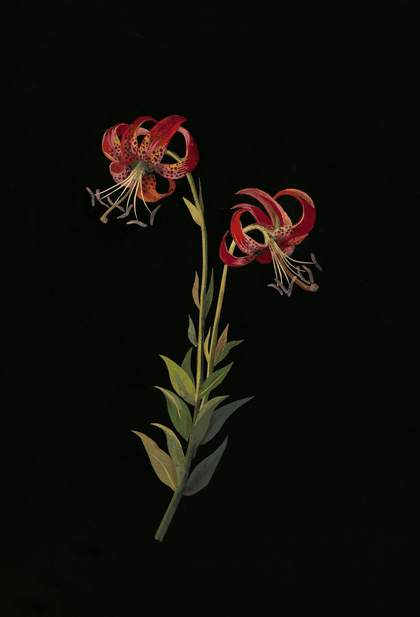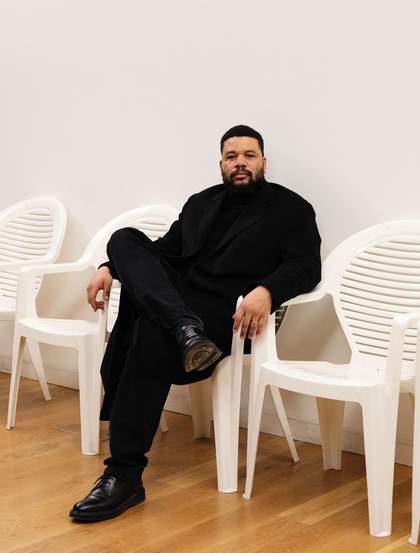
Oscar Murillo photographed by Tim Bowditch, 2023
© Oscar Murillo. 2023. Photo: Tim Bowditch, courtesy the artist
CATHERINE WOOD I’d like to start with Colombia, where you’ve spent a good part of the past few years, including the pandemic. Did you get productively stranded there or had you planned on staying?
OSCAR MURILLO I had only planned on being there for six months. I had a show at the Art Museum of the National University of Colombia in 2019 and had been preparing to move the studio there from London – somewhat resentfully, because I’ve always had a difficult relationship with Bogotá, this geographical island, almost 3,000 metres above sea level.
CW Was that something you felt growing up?
OM I don’t think I had been conscious of it before my family and I left for London, but I definitely became aware of it later in life. You land in Bogotá and fly out of Bogotá, and therefore have no relationship to the rest of the country.
I was getting ready for the move to Bogotá when the pandemic hit. I thought, instead of trying to get back to Europe, let me find refuge in my hometown, La Paila, the place I was born. It quickly became an oasis: everyone else was locked down too, so we helped each other and had easy access to nature. I was able to become part of the community and busied myself with helping, observing and learning.
CW What did you learn during that time?
OM It was an opportunity to witness the way the town was being shaped by the arrival of refugees from Venezuela. There are now something like three million refugees living within Colombia alone.
While I was there, you could see thousands and thousands of Venezuelans just walking the highways aimlessly, with kids and family. It was really catastrophic. And of course, over the years, my hometown has changed. The population is maybe only 15,000, and three or four per cent of that population are of Venezuelan nationality – and there is a stigma towards them. Watching this happen there in such a micro context was a real eye-opener regarding the brutality of the human condition.
CW Migration has been a recurring theme in your work. Does that relate to your own story?
OM In some ways, yes. For example, I did a show in New York in 2014 called A Mercantile Novel which explored migration – my history of migration. In the gallery, we set up a version of a factory founded in La Paila, the Colombina food factory, and brought over experienced employees from Colombia to run it. Over a year, setting it up became a bureaucrat- ic process of applying for visas, of paper- work and conversations with the factory in Colombia, and working with the gallery and lawyers to have 14 people make this trip, each with US working visas for up to 10 years.
CW So you used the representational power of the exhibition to effect real change in the participants’ working lives?
OM Yes. After the show, a group of them returned to Colombia to work at the original La Paila factory for a few more years, then quit and moved back to the US. They have green cards now.
CW Very interesting. The exhibition was quite controversial at the time, wasn’t it?
OM It was a show that cut through the speculation around and misunderstanding of my practice – about where I was coming from. The show was ambiguous, and in a way, I like that ambiguity; it’s something that continues to unravel.
CW It’s intriguing how your practice is unfolding across your career, and how the integrity of some of your moves is becoming more visible.
OM With time, yes.
CW Some people see you only as a painter, primarily because the paintings have had such presence and success.
OM In a way, I am. To me, my paintings are a representation or symbol of my practice.
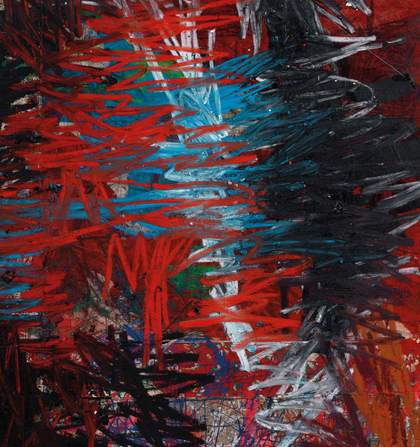
Oscar Murillo
manifestation 2020–2
© Oscar Murillo. Photo: Kerry McFate, courtesy the artist and David Zwirner
CW I’m really interested in your paintings as dense, material passages or markers, but also in the way they can create a social space. In Colombia you created ética y estética, an exhibition of new paintings situated in a church in La Paila, where people often gathered for worship or social occasions. There has often been a symbolic social dimension to the presence of your paintings.
OM They became almost like a crescendo. That was the beginning of not having any other tools but painting – and, to some extent, words, in painting – to communicate these ideas.
CW You moved to London when you were nine. What were your impressions of the city then and what do you think of it now?
OM London is one of the most cosmopolitan cities there is, because the world comes through it: historically, financially, culturally and also physically, in the con- text of migration.
Migration didn’t have any hostile connotations when I moved here in the 1990s, though. Because of the positive shift then, from a Conservative government to New Labour, and the resulting new energy in the country and London’s growth, the city was so hungry. Migration was necessary; human resources were necessary to push through this neoliberal project.
Life was also precarious, though. We lived in Hackney, and it was a bit of a wild west then. When we moved to our apartment, we didn’t have anything, so we would walk around the streets to find furniture, sofas, mattresses, fridges, washing machines.
But, because there were so many of us, there was a semblance of our culture – we became this pack. We would catch the train to Margate, Brighton, Southampton or Poole and take over a whole carriage. Even if people had wanted to be horrible, they couldn’t, because there were just too many of us. Maybe that kept our spirits from being broken.
CW Play as a concept is something you’ve addressed explicitly in your participatory work with children, and in your parties. This project looks like play – in the sense of asking the public to come and paint freely – but is it?
OM It is, but there is a tension there. If it was just a party, there would still be the sense of ‘we’ve got to wake up at four o’clock in the morning to go to work’. Looking at the idea of carnival in any part of society – the Caribbean or the Irish idea – there are moments of release, of transgression, and also a kind of therapeutic exercise.
CW You’ve spoken before about drawing during flights to fill time; this ability to go into your head and make marks. Whether it’s play or not, this is something you’ve always tried to give other people as well – a sense of freedom in a confined or rigid environment.
OM Yes, it takes me back to when I moved to this country. I couldn’t go back to Colombia because I was undocumented. I couldn’t speak English and I had no relationship to the cultural dynamics. The only thing I had was drawing, and the memory of a few key friends, for example artist Jaqueline Soto, as a form of connecting to my identity. Drawing released me from that confined reality of not speaking the language. Of not being able to go home. And then, of course, ironically, many years later, I found that a plane can give that space back to you.
CW Do you paint every day?
OM It depends on the body of work, but I try to paint in bursts; I think it feels more substantial if it’s produced in a concentrated period of time, because it’s also in relation to everything else I do: kids and family and obligations, life and so on.
CW And you are someone who lets life come into the work.
OM Yes, it’s a great part of it, but then to really protect or to give priority or purity to that experience of concentrated work, you’ve got to cut off from other life and you’ve got to cut it off radically. But you can only cut it off for so long. This is why the pandemic was so important.
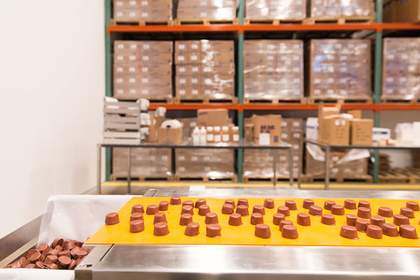
Oscar Murillo
A Mercantile Novel 2014 Installation view at David Zwirner Gallery, New York
Photo: Scott Rudd, courtesy the artist and David Zwirner, 2014
CW Because you had that sustained period of intensity?
OM Yes, and I try to replicate it, perhaps twice a year for a month, when I don’t answer the phone.
CW I see those things come together in your approaches to the sites for your work, to painting as a form of soft architecture, and in your project for Tate Modern: this idea of inviting people into the space of your painting, not just putting paintings up according to the atomised logic of how people inhabit the white cube gallery space. What does it mean to work in such a porous public museum atrium – a space open to everybody?
OM The starting point is this most radical public policy – the free museum. The fact that a working-class kid or a kid from an affluent background, Black, white, Indigenous, Asian, can get a free bus or train and spend a day at the museum. That idea infiltrates the public and encourages them to have a positive relationship with culture in a more far- reaching way than any educational mandate, because you have these kids coming into the museum of their own free will.
CW You think it’s that feeling of it being yours – as the visitor – and that you can roam.
OM It’s important that it’s like planting a seed: let it just be. To go back to the project, one of the things that clicked when I visited was that the Turbine Hall is, architecturally, known as The Street. The river, the embankment and how popular walking along the river has been historically, combined with the idea of people arriving in floods: this is where the title comes from – the idea of flooding the museum with people.
CW That’s true of Tate Modern, like few other museums: there is no barrier to visitors flowing into the space and having an encounter with art. Then you have the question of popularity, which makes me think of Monet and his water lily paintings – another inspiration for the project. You’ve been thinking about these paintings for a long time in your own practice, haven’t you?
OM Yes, I think of them in relation to the cataracts that affected Monet’s vision, in relation to beauty, despair and pain – the idea that he was suffering and impaired, but was so against the idea of surgery, because it was not a commonplace procedure at that time.
CW It would be quite terrifying, wouldn’t it?
OM Yes, I couldn’t imagine how, as an artist, you could come to terms with slowly losing your sight. To me, this antagonistic reality, the idea that he was fighting through something, was perhaps the only way I could enter his work or enter beauty.
CW You are pulling back from the idea of the easy, sweet consumption of impressionism, to show that Monet was grappling with this blindness, but through that, creating something beautiful.
OM I think of him as a vessel, carrying forward these ideas through his painting in spite of, or maybe because of, his blindness. These ideas also play out in this monumental project, which leads to the idea of the flooded garden, the public flooding the museum with their work.
CW We’re below the waterline of the Thames, here in the Turbine Hall.
OM Yes, and the river also has obvious connections to trade, transport and Empire.
CW You are opening up from the solitary space of the studio to this collective input and unconscious, and the design of the commission will resemble the Musée de l’Orangerie’s Monets in Paris.
OM What’s nice about this is the individual element. I don’t want to interfere, just to help orchestrate the work. I am curious to see how people will respond, because they are also going to be blinded, in the sense that they won’t be able to see the work in its entirety – it’s only going to be possible to focus on one section at a time. Then, of course, there is a violence there, as well.
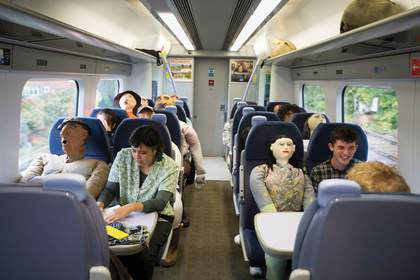
Volunteers transport Oscar Murillo’s collective conscience 2019 on a Southeastern train from London St Pancras to Turner Contemporary in Margate for the 2019 Turner Prize exhibition
Photo: David Parry/PA Wire, courtesy the artist and Turner Contemporary
CW Yes, another idea that has always been consistent in your practice: the ways in which the politics and ideas in the marks people make will, inevitably, be erased by other people – as will occur in this piece. Will you offer instructions?
OM No, the only instructions are in relation to the colour palette. That’s it.
CW What does a project like this, with public participation, open up for you and what do you hope it will open up for the visitors who take part?
OM There is a two-fold experience. There is the drawing aspect, however profound or trivial, which may also have weight because of its setting in the Turbine Hall of Tate Modern. Hopefully visitors will feel something in the sense of contributing to a project in, and for, a museum of such history. And then the visitor can go upstairs and see that history, and possibly gain a sense of the trajectory of which they have been a part. But what I’m most excited about is the idea of the singular experience one can have through drawing – by the multi-individual.
CW Multi-individual is a really nice way of thinking about it, rather than a mass participation.
OM And drawing is special. Drawing is more internal, while painting is more external: a little like the difference between writing a diary entry and singing.
CW Is that how it will feel for you?
OM It’s very different for me because I will then respond to and work with these drawings. The canvases will be sewn together and the larger canvas, this tapestry, will be composed of the singular fragments on the floor. In so doing, you encounter information, things or characters, marks you want to work with, and others you might have to paint over. ‘Oh, this is beautiful’ or ‘How can I get rid of this?’ There is a real push and pull in that process.
CW In the encounter with other people’s subjectivities and marks?
OM Yes, some of those marks will remain and others will become more pronounced, highlighted. And none of it will be of my making. It will be a collective exercise to see what eventually stays.
CW To see what happens, in the wildness of the experiment.
OM Yes, exactly.
CW I can’t wait.
Uniqlo Tate Play: Oscar Murillo, The flooded garden, Turbine Hall, Tate Modern, 20 July – 26 August.
Oscar Murillo is an artist born in Colombia and based in various locations.
Catherine Wood is Director of Tate Modern Exhibitions & Programmes.
UNIQLO Tate Play in partnership with UNIQLO.

